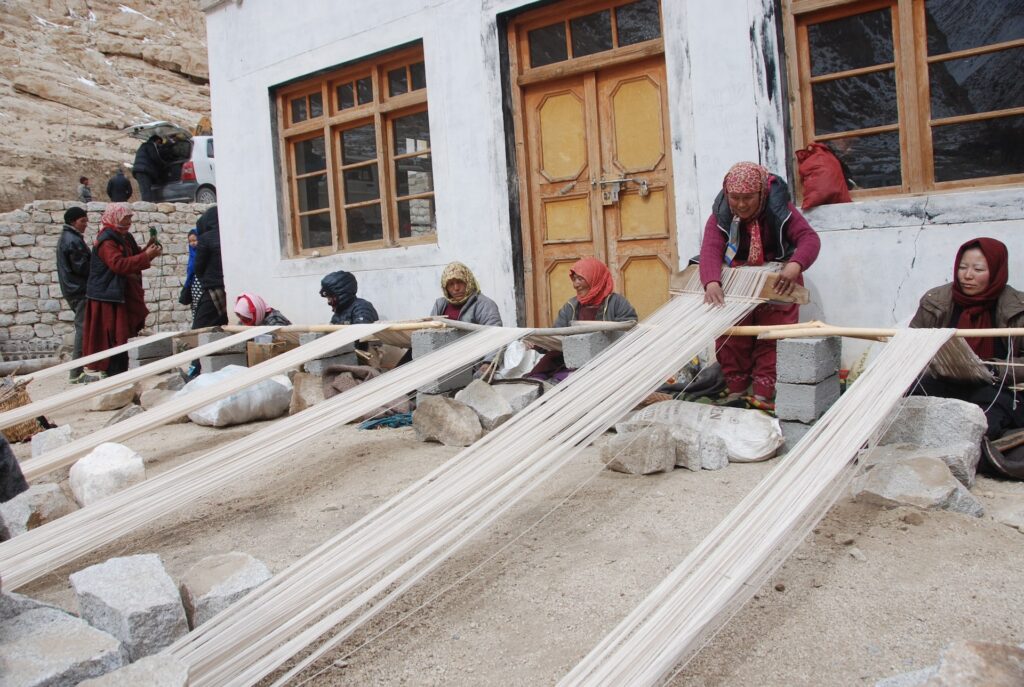
Many mammal species grow very thin and soft hair in the underbelly – the layer in contact with the skin. The hair is much softer than the outer layer. To use it as a raw material for a garment, the soft hair is segregated from the coarse hair and the process of segregation is either done manually or through a machine which is called dehairing. In Ladakh, ACPGMS directly procures the raw fibre from nomadic communities from Changthang and processes it in their dehairing centre in Skalzangling (Leh, Ladakh).
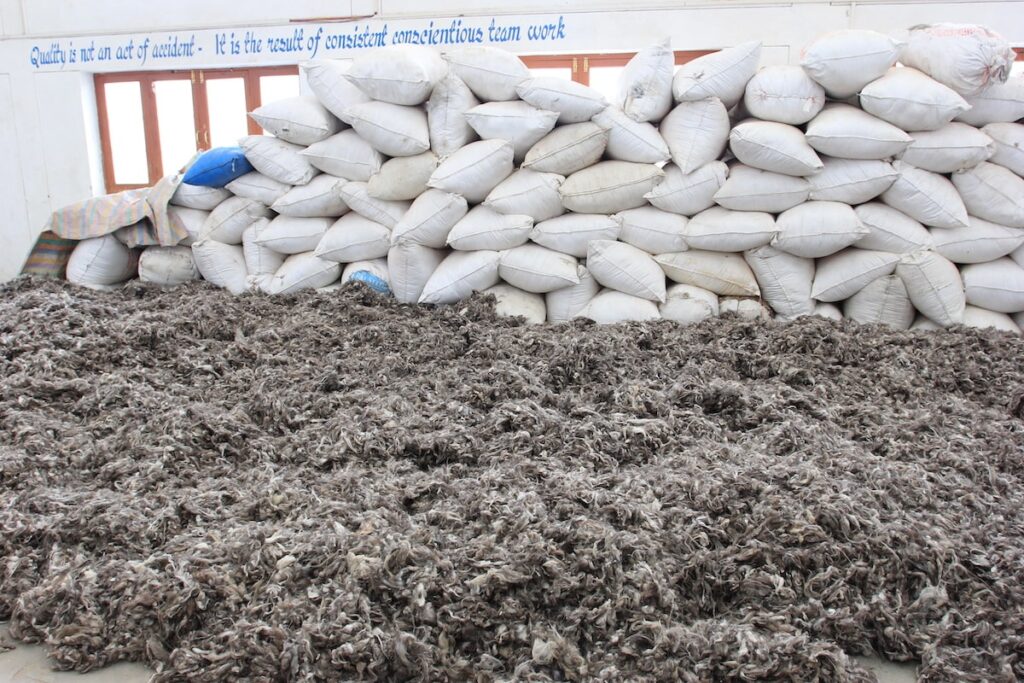
Initially, all the raw wool collected from various are manually colour sorted; there are three natural wool colours of Pashmina goat – white, black and light brown (camel color) and the raw wool is stretched bit by bit by hand before putting it in the cleaning machine. At this point the raw material they collected from herding communities is coarse and is full of impurities. Colour sorting of the wool is important so as not to mix the wool of different colours in the machine for it loses its colour while washing.
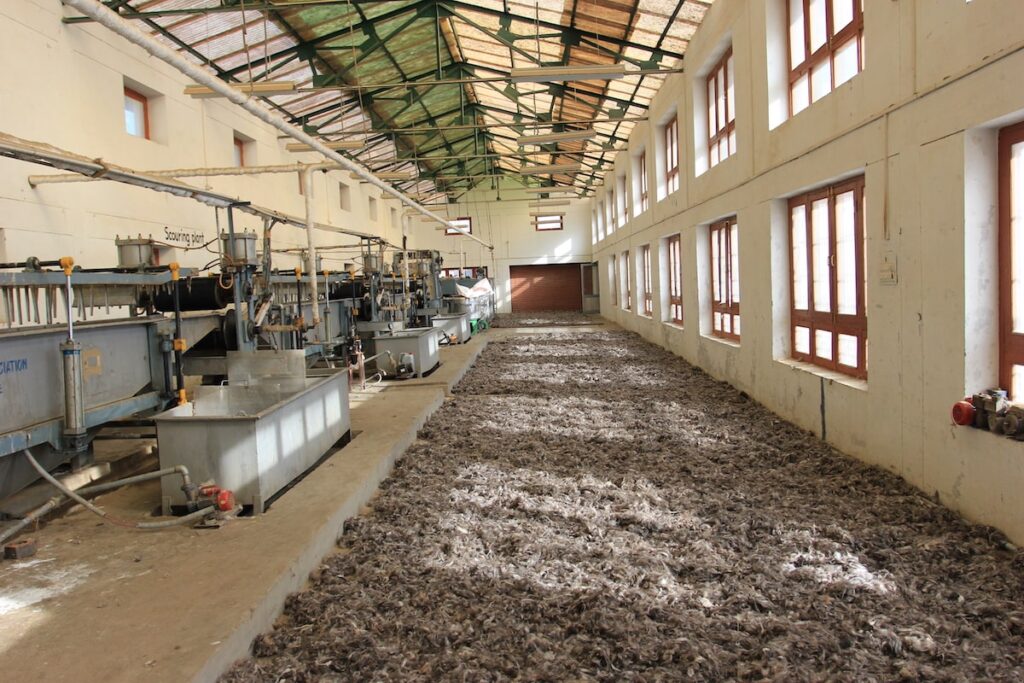
Bundle (at least 100 Kg is required to process in a machine) of raw wool is then put in the cleaning machine where it undergoes various stages of cleaning process. A rough segregation and stretching of raw wool are done by machine before it falls into a willowing box. The bulk wool is further segregated into coarse hair and soft hair. The soft hair is passed in the cleaning bowl while the coarse hair falls on the ground and is put in a separate chamber for a second layer of segregation. In the first stage, the workers ensure bulky impurities like dust, sand, dandruff, vegetation particles and greasy substances are removed from the fleece. The raw wool sheared from Changthang goats have a lot of contamination stuck on their due to grazing in high pastures and these impurities are removed during the cleaning process. The greasy substance and other impurities make up for almost 40% of the total fleece weight.
During the scouring process, wool is fed into a series of cleaning bowls to further remove grease and finer dust particles. The first bowl contains chemicals for washing. It is then transported to a second bowl where wool washing happens with the use of detergent. The third bowl comprises warm water where the wool is washed and rinsed off. Mud and grease are effectively removed during the scouring process. The wool is then put into Drying chamber where excess water is removed and further laid outside for sun drying. The scoured wool is then transported to a conditioning chamber where it is thoroughly blended and conditioned till the moisture content reaches equilibrium. After conditioning, the wool further undergoes the dehairing process where the soft wool and the coarse wool are segregated and put in two different bowls· Finally, the clean dehaired wool is passed through a carding machine where wool is further detangled and blended to produce lumps of fine fibre for end use like spinning, felting etc.
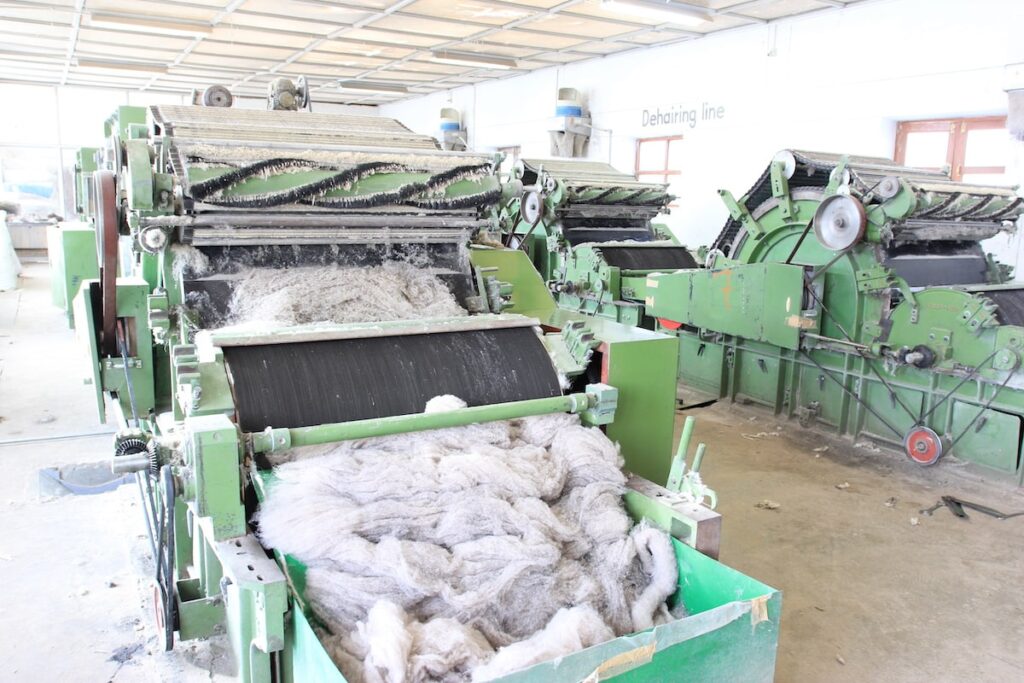
After thorough cleaning and dehairing, the coarse wool is collected in gunny bags while the dehaired wool is passed to a laboratory section located in the plant for quality check. A representative from the sheep husbandry department visits the center once in a month to determine the micron size, length and finesse of wool. After dehairing, only a fraction of clean hair is usable for sale, cashmere production and value addition processes like weaving, spinning, yarn making etc. The fallen hair or the coarse wool makes up for more than 60%. if the raw material weighs 100 kg before scouring, the clean dehaired wool weighs only about 27-29 kg. The rest is not suitable for product making. The coarse wool however takes another life when it is sold to Kashmiri traders, locals people and to SECMOL who buys coarse wool in bulk to be used in various works like mattress making, building solar houses where the coarse wool is used for insulation. It is interesting to note how the coarse (guard) Pashmina hair which is not used for fabric production takes on another life with the backend supply chain when it is sold to local traders.
Ladakh is primarily known as the raw Pashmina producer and the herder’s cooperative society All Changthang Pashmina Growers Co-operative Marketing Society (ACPGCMS) is the nodal agency dehairing raw Pashmina wool locally while promoting the interest of Changthang herders who are on the margin of the whole Pashmina value chain. The Cooperative has been able to provide consistently higher rates to the livestock rearers- even during severe international and national Pashmina price fluctuation. From giving INR 1500/- per kg of A grade raw Pashmina wool in 2010-11 to INR 3000/- per Kg in 2019-2020, there has been a steady move towards fair compensation for the livestock rearing community. The rates for raw pashmina wool and the dehaired pashmina wool is annually fixed during the board meeting of Cooperative where representatives of village heads (numberdar or sarpanch) and cooperative members are present. Last year (2019-20) the price for raw Pashmina wool of A grade was INR 3000/- per Kg and the price of dehaired wool (White) was INR 10, 210/- per Kg, Grey and red dehaired wool for INR 10, 500/- per Kg. The price for grey and red wool is more because red and grey goats are less in Changthang compared to white goats.
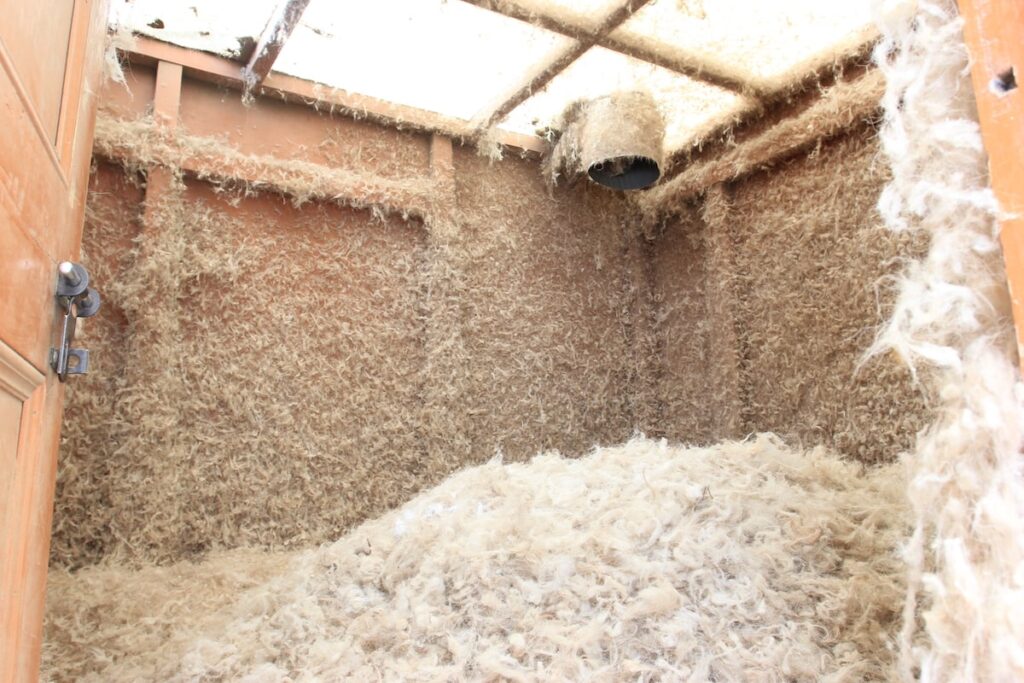
The dates for Pashmina procurement in various villages of Changthang are decided by herding communities depending on when they are done with wool shearing. Shearing happens in the month of June and raw Pashmina procurement is mostly done by July end. Eight villages in Changthang produce A grade wool (Samad, Kharnak, Korzokh, Sumdo Yogma, Sumdo Gongma, AngKhung, Churmur, Chumur TR). B grade wool is found in villages like Dorzok, Nyoma. Lalok, Durbuk block, Hanle, Rongo valley, Tsaga and Gya-Miru. The price for raw B grade Pashmina wool is little less than the A grade wool and the pricing for different wool is based on the quality.
After combing and dehairing, the wool is carded to produce thin fine fibre. The wool undergoes spinning and weaving processes to make various products. Most of the dehaired wool is sold to private traders from Kashmir, Himachal Pradesh and Punjab for further processing and in recent years, value addition works are undertaken by different Ladakh based – Ladakhi owned entrepreneurs like Looms of Ladakh, Lena Ladakh, Nomadic Woollen Mills, Zilzom, Jigmat Couture among few who directly purchase dehaired Pashmina wool from ACPGMS and independently undertake the processing works with local women’s groups and SHGs in their units. Looms of Ladakh – the women’s cooperative have around 200 members across their 7 centres in Ladakh while Lena Ladakh works closely with 27 women artisans who are engaged in spinning and weaving works. They procure the wool from the dehairing plant, distribute the raw material to women artisans associated with them who will undertake the handicraft work either in their home or from various centers.

Spinning is done throughout the year and is especially more suitable during winter months when all the farm work is done and women can undertake the task manually in their household. In many villages, it is traditionally hand spun and woven for their own use. Many Ladakhi women are experienced wool spinners and they learn it at a young age from their mothers- an heirloom skill passed from one generation to another. They use willow spindle “phang” supported by an apricot kernel bowl “phang kor” or a ceramic bowl for spinning yak wool and sheep wool. Spinning Lena (Pashmina) requires more dexterity as the fibre is delicate and tends to break when hand stretched.
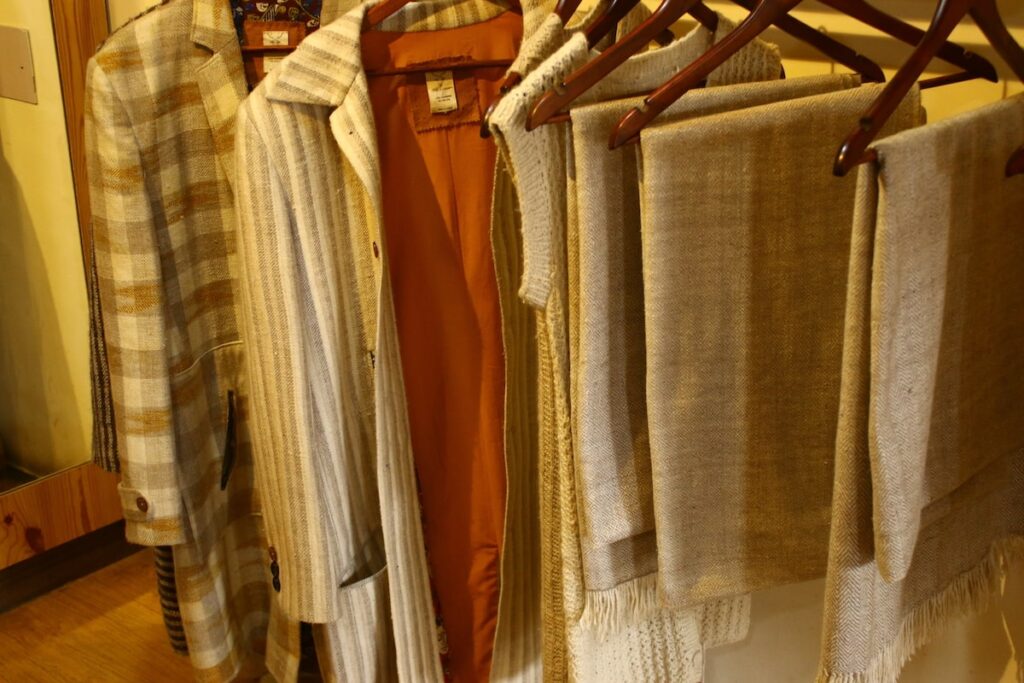
With Charkas and industrial looms, the process is more mechanized these days and the fibre is processed through various stages to design a final product. Charka spinning came to Ladakh much later and women undergo training for that; it is less time consuming and produces thin thread but more inconvenient for the spinner. Most Ladakhi spinners are more comfortable with the slow paced Phang spinning which produces ideal pashmina thread size and doesn’t break. The textile is then dyed but the shades are restricted to reds, maroons and browns. Experimentation with natural dyes techniques are slowly becoming more popular where extracts of walnut shells, marigold flowers, saffron, madder, lac, arnebia, indigo and wild rose are used. Once spun and dyed, the weaving process begins either on the foot loom or the backstrap loom. Handwoven products like Tsukden (carpet), rugs, shawl and hand knitted items like sweaters, stole, gloves, hats are made followed by finishing and refining works where dandruffs are removed and in case of certain handcrafted items like Pashmina shawls/stoles are hand washed and hand pressed to retain the soft quality.

